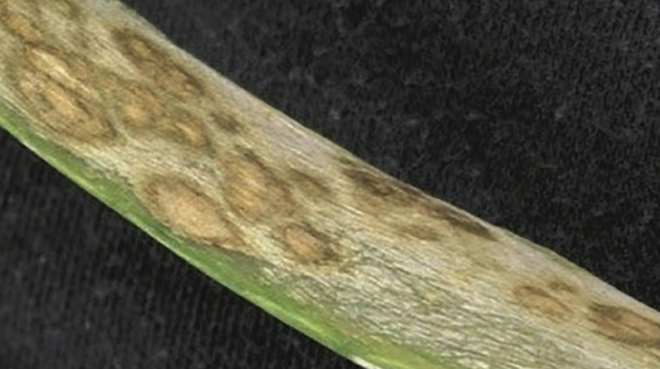

Feb 26, 2022Thrips hit onions; foliar disease boosts risk
Onion thrips are a major challenge to organic growers and to growers who grow onions with conventional practices. Foliar diseases like stemphylium are also a major challenge.
New research from Michigan State University (MSU) is finding a link between the two – with more onion thrips in fields that have more foliar disease.
That’s the message from Zsofia Szendrei, associate professor in MSU’s Entomology Department. Szendrei talked about the onion thrips research at the recent Great Lakes Fruit, Vegetable & Farm Market EXPO held in Grand Rapids, Michigan.
Fifteen fields of commercial onion production – seven organic and eight conventional – were regularly visited by researchers over the summer. The thrips populations were counted and the amount of foliar disease measured.
In general, there was no difference in the number of onion thrips per leaf found between the organic and conventional farming systems. Onion thrips populations in both systems also never reached numbers requiring treatment.


a relationship between onion thrips and other pathogens. The onion thrips were more prevalent on diseased plants. Photo: Dean Peterson
“The pressure from onion thrips was essentially the same in each farming system and stayed below threshold over the whole season,” Szendrei said.
However, some of the conventional fields had about twice as much foliar disease as the organic fields. The fields with more foliar disease also had more onion thrips per leaf and thrip populations were slightly more than the treatment threshold.
“There is a relationship between onion thrips and other pathogens,” Szendrei said. “Onion thrips were more prevalent on diseased plants.”
Thrips damage onions by puncturing one cell after another.
“Thrips could be opening entry points for disease and could be helping the pathogens spread by carrying them from plant to plant,” Szendrei said.
Field history could be another reason. “Conventional farmers may have been growing onions in the field longer so more disease pathogens may be present,” Szendrei said.
The study also tested organic pesticides for onion thrips control.
In 2020, researchers compared Neem Oil, Entrust, Neem Oil plus Kocide 3000, Entrust plus Kocide 3000 and Kocide 3000 alone to an untreated control. The study was repeated in 2021 with a change that Neemix 4.5 was used instead of Neem Oil. The products are all OMRI-listed (Organic Materials Review Institute).
Neem is an extract of an ornamental shade tree in India.
“It has many, many formulations and trade names,” Szendrei said. Neemix 4.5 was selected in 2021 to help ensure product consistency.
Entrust (spinosad) is produced through the fermentation of a naturally occurring soil bacterium. Kocide 3000’s active ingredient is copper hydroxide. All three products were applied with a surfactant.
In comparison, all of the organic pesticides performed similarly to each other, but only managed onion thrips slightly better than the untreated control.
“The organic products did not control onion thrips,” Szendrei said. “They helped but did not get the thrip populations below threshold. We don’t yet have a silver bullet for thrips if you’re trying to grow organic onions.”
— Dean Peterson, VGN correspondent














